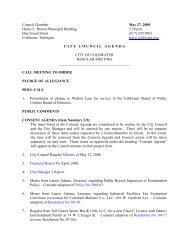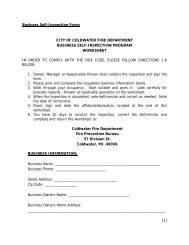Landlords
Tenants and Landlords - Landlord Protection Agency
Tenants and Landlords - Landlord Protection Agency
You also want an ePaper? Increase the reach of your titles
YUMPU automatically turns print PDFs into web optimized ePapers that Google loves.
› If the rent, or a portion of it, will bewithheld for the purpose of addressing themaintenance or repair issue(s), the tenantshould send a letter—certified mail, returnreceipt requested—stating why the rent willbe withheld, where it will be deposited(name of financial institution), and thatpayment will be released when themaintenance or repair problem(s) has beencorrected.› If the repair cost will be deducted from therent, call for three repair estimates. If it is ado-it-yourself job, shop and compare the costof parts. Reputable repair companies willcome to the house and provide a free writtenestimate. Send copies of the estimates to thelandlord and state that the problem will befixed unless the landlord agrees to do it by acertain date, and that the cost of repair willbe paid from the rent withheld. Keep allreceipts and note the dates of repair; sendcopies to the landlord, along with theremaining portion of the rent.Note: While the repair-and-deduct methodmay work well for small repairs, it may notwork for large repairs.Q1 How much rent should be withheld?The amount of rent withheld mustreasonably relate to the cost of fixing theproblem or to the amount of damage thetenant has incurred because of the landlord’sfailure to fix the problem. Withhold less for aclogged drain. Withhold more for an unusabletoilet or shower. Only the most catastrophicproblems will warrant withholding all of therent. In any event, the amount withheld mustbe deposited into an escrow account.Q2 What if the tenant lawfully withholdsrent and the landlord starts theeviction process?If the landlord has a run-in with themunicipal code enforcement office OR if thelandlord does not receive the rent, he or shemay well decide to start the process forevicting the tenant. Nevertheless, Michigan lawprovides the tenant—who was acting lawfully—with certain defenses. The tenant, however,must be able to prove the facts giving rise tothe defense:1. A claim of retaliatory eviction. There exists apresumption of retaliation if the landlordstarted the eviction proceedings within90 days of the tenant trying to enforce hisor her rights under law (e.g., reportinghealth and safety code violations, exercisingrights under the lease, filing a complaintagainst the landlord for a violation of thelaw).2. The landlord’s breach of the warranty ofhabitability and duty to repair. The tenantmust show that the landlord was providedwith notice of the problem and given areasonable amount of time to fix theproblem. The tenant must show that thelandlord failed to make the necessaryrepairs.3. Rent was properly withheld and escrowed.The tenant must be able to show that “butfor the repair and maintenance required, heor she was ready, willing, and able to paythe rent.”The eviction process takes time—from startto finish, it takes as few as 27 days or as manyas 57 days to evict a tenant. In the meantime,the landlord has mortgages, taxes, and bills topay. Financial pressure may cause the landlordto negotiate. If the landlord will not negotiate,and if the tenant has carefully documented allcommunications about the needed repair andmaintenance, the tenant may well succeed inthe lawsuit for eviction.Both the landlord and the tenant shouldremember that, in many disputes, the basicissues become obscured by personaldisagreements that develop and continue togrow and fester. If an agreement cannot bereached, try mediation—either before a lawsuitis filed or after. Mediation might help toempower the parties to use their own problemsolvingskills, to take responsibility, and to findsolutions that best meet their needs, whilestrengthening the landlord-tenant relationship.28





